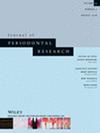Salivary Proteomics for Detecting Novel Biomarkers of Periodontitis: A Systematic Review
Abstract
Aim
Salivary content is regarded as a powerful diagnostic window for oral and systemic diseases and the proteomic profile could be useful to distinguish between different periodontal conditions. The aim of the present systematic review was to assess distinctive salivary proteins identified through untargeted proteomics in periodontitis patients compared to periodontally healthy and gingivitis subjects, as well as to provide a qualitative methodological assessment of the current literature.
Methods
Relevant studies identified from Medline via PubMed, Scopus, Embase, and Cochrane Library databases were retrieved to answer the following PECO question: “In systemically healthy individuals, are there any differences in salivary protein expression profiles assessed in proteomics studies between patients with periodontitis and periodontally healthy or gingivitis subjects?” Moreover, diagnostic utility of the identified markers was sought via a targeted literature search and further quantitative assessment. A modified version of the QUADAOMICS tool was used for the quality assessment of the included studies.
Results
After screening 461 relevant articles, a total of 13 studies were selected. The number of identified discriminant salivary proteins ranged from 2 to 4161. However, it was possible to identify proteins that were consistently over- or under-expressed in periodontitis patients in at least 3 studies. Among these, complement C3, profilin-1, SA100A8, and fibrinogen were consistently reported as increased in periodontitis, while cystatin-SN and leukocyte elastase inhibitor were more elevated in periodontally healthy controls. Only 4 studies reported diagnostic accuracy measures, with SA100A8 showing an area under the curve of 0.71 (95% CI: 0.66–0.75) in meta-analysis.
Conclusions
Untargeted proteomics techniques identified some key biological molecules which were consistently reported to be over- or under-expressed in periodontitis. These findings could be useful to support novel candidate biomarkers for periodontitis. The high level of heterogeneity in methods and reporting urge to develop standardized protocols to be implemented in this research field (PROSPERO CRD42022299826).


 求助内容:
求助内容: 应助结果提醒方式:
应助结果提醒方式:


